Efficiency of Phosphorus Use in Sunflower
Abstract
1. Introduction
2. Materials and Methods
2.1. Location and Characterization of the Experimental Area
2.2. Experimental Design
2.3. Implementation and Conduct of the Experiment
2.4. Response Variables
2.5. Statistical Analysis
3. Results
3.1. Productivity of Achenes
3.2. Agronomic Efficiency (AE)
3.3. Physiological Efficiency (PE)
3.4. Agrophysiological Efficiency (APE)
3.5. Apparent Recovery Efficiency (ARE)
3.6. Utilization Efficiency (UE)
4. Discussion
4.1. Agronomic Efficiency (AE)
4.2. Physiological Efficiency (PE)
4.3. Agrophysiological Efficiency (APE)
4.4. Apparent Recovery Efficiency (ARE)
4.5. Utilization Efficiency (UE)
5. Conclusions
Author Contributions
Funding
Data Availability Statement
Acknowledgments
Conflicts of Interest
References
- Kostenkova, E.V.; Bushnev, A.S.; Vasilko, V.P. The study of Helianthus annuus L. of domestic breeding in arid Crimea. IOP Conf. Ser. Earth Environ. Sci. 2019, 341, 012011. [Google Scholar] [CrossRef]
- ADeleke, B.S.; Babalola, O.O. Oilseed crop sunflower (Helianthus annuus) as a source of food: Nutritional and health benefits. Food Sci. Nutr. 2020, 8, 4666–4684. [Google Scholar] [CrossRef] [PubMed]
- Rocha-Filho, D.; Alves, P.; Maruno, M.; Ferrari, M.; Topan, J.F. Liquid crystal formation from sunflower oil: Long term stability studies. Molecules 2016, 21, 680. [Google Scholar] [CrossRef] [PubMed]
- Vilvert, E.; Lana, M.; Zander, P.; Sieber, S. Multi-model approach for assessing the sunflower food value chain in Tanzania. Agric. Syst. 2018, 159, 103–110. [Google Scholar] [CrossRef]
- Viana, T.D.A.; Lima, A.D.; Marinho, A.; Duarte, J.D.L.; Azevedo, B.M.; Costa, S.C. Irrigation depths and soil coverings in sunflower crop under semiarid conditions. Irriga 2012, 17, 126–136. [Google Scholar]
- Mohammadi, K.; Heidari, G.; Javaheri, M.; Rokhzadi, A.; Nezhad, M.T.K.; Sohrabi, Y.; Talebi, R. Fertilization affects the agronomic traits of high oleic sunflower hybrid in different tillage systems. Ind. Crops Prod. 2013, 44, 446–451. [Google Scholar] [CrossRef]
- Baskaran, R.; Kavimani, R. Productivity of sunflower as influenced by tillage and weed management. Indian J. Weed Sci. 2014, 46, 138–141. [Google Scholar]
- Arif, M.S.; Riaz, M.; Shahzad, S.M.; Yasmeen, T.; Akhtar, M.J.; Riaz, M.A.; Buttler, A. Associative interplay of plant growth promoting rhizobacteria (Pseudomonas aeruginosa QS40) with nitrogen fertilizers improves sunflower (Helianthus annuus L.) productivity and fertility of aridisol. Appl. Soil Ecol. 2016, 108, 238–247. [Google Scholar] [CrossRef]
- Nafady, N.A.; Hashem, M.; Hassan, E.A.; Ahmed, H.A.; Alamri, S.A. The combined effect of arbuscular mycorrhizae and plant-growth-promoting yeast improves sunflower defense against Macrophomina phaseolina diseases. Biol. Control 2019, 138, 104049. [Google Scholar] [CrossRef]
- Adebayo, A.G.; Akintoye, H.A.; Olatunji, M.T.; Shokalu, A.O.; Aina, O.O. Growth response and flower yield of sunflower to phosphorus fertilization in Ibadan, southwestern Nigeria. Rep. Opin. 2010, 2, 29–33. [Google Scholar]
- Soleimanzadeh, H. Response of sunflower (Helianthus annuus L.) to inoculation with Mycorrhiza under different phosphorus levels. Am. Eurasian J. Agric. Environ. Sci. 2012, 12, 337–341. [Google Scholar]
- Salih, M.N.T. Response of sunflower (Helianthus annuus L.) to phosphorus and nitrogen fertilization under rainfed conditions, Blue Nile State-Sudan. Helia 2013, 36, 101–110. [Google Scholar] [CrossRef]
- Banerjee, H.; Dutta, S.K.; Pramanik, S.J.; Ray, K.; Phonglosa, A.; Bhattacharyya, K. Productivity and profitability of spring planted sunflower hybrid with nitrogen, phosphorus and potassium fertilizer. Ann. Plant Soil Res. 2014, 16, 250–256. [Google Scholar]
- Li, S.T.; Yu, D.U.A.N.; Guo, T.W.; Zhang, P.L.; Ping, H.E.; Majumdar, K. Sunflower response to potassium fertilization and nutrient requirement estimation. J. Integr. Agric. 2018, 17, 2802–2812. [Google Scholar] [CrossRef]
- Ullah, S.; Akmal, M. Response of sunflower to integrated management of nitrogen, phosphorus and sulphur. Sarhad J. Agric. 2018, 34, 740–748. [Google Scholar] [CrossRef]
- Ali, A.; Ullah, S. Effect of nitrogen on achene protein, oil, fatty acid profile, and yield of sunflower hybrids. Chil. J. Agric. Res. 2012, 72, 564. [Google Scholar] [CrossRef]
- Abbadi, J.; Gerendás, J. Effects of phosphorus supply on growth, yield, and yield components of safflower and sunflower. J. Plant Nutr. 2011, 34, 1769–1787. [Google Scholar] [CrossRef]
- Sadozai, G.U.; Farhad, M.; Khan, M.A.; Khan, E.A.; Niamatullah, M.; Baloch, M.S.; Wasim, K. Effect of different phosphorous levels on growth, yield and quality of spring planted sunflower. Pak. J. Nutr. 2013, 12, 1070. [Google Scholar]
- Aguiar Neto, P.; Oliveira, F.A.; Marques, L.F.; Rodrigues, A.F.; Santos, F.G.B. Effects of phosphorus application on sunflower crop growth. Green J. Agroecol. Sustain. Dev. 2010, 5, 24. [Google Scholar]
- Grant, C.A.; Flaten, D.N.; Tomasiewicz, D.J.; Sheppard, S.C. The importance of early season phosphorus nutrition. Can. J. Plant Sci. 2001, 81, 211–224. [Google Scholar] [CrossRef]
- Prado, R.D.M.; Moreira Leal, R. Desordens nutricionais por deficiência em girassol var. Catissol-01. Pesqui. Agropecuária Trop. 2006, 36, 187–193. [Google Scholar]
- Soomro, F.; Talpur, N.A.; Soothar, M.K.; Jamro, S.B.; Panhwar, A.A.; Memon, N.A.; Soomro, M.H. Identification of phosphorus use efficiency of different sunflower genotypes at Tandojam-Pakistan. Pure Appl. Biol. 2018, 7, 1026–1037. [Google Scholar] [CrossRef]
- Schultz, E.; DeSutter, T.; Sharma, L.; Endres, G.; Ashley, R.; Bu, H.; Franzen, D. Response of sunflower to nitrogen and phosphorus in North Dakota. Agron. J. 2018, 110, 685–695. [Google Scholar] [CrossRef]
- Braga, D.F.; Oliveira, F.H.; Santos, H.C.; Araújo, A.P.; Zonta, E. Nitrogen and phosphorus fertilization of sunflower crop in alkaline Cambisol. Braz. J. Agric. Environ. Eng. 2018, 22, 101–106. [Google Scholar] [CrossRef]
- Kalaiyarasan, C.; Sriramachandrasekharan, M.V.; Jawahar, S.; Suseendran, K.; Ramesh, R.; Ramesh, S.; Kanagarajan, R. Growth and yield of sunflower as influenced by VAM and phosphorus application. J. Pharmacogn. Photochem. 2019, 8, 836–839. [Google Scholar]
- Nendel, C.; Melzer, D.; Thorburn, P.J. The nitrogen nutrition potential of arable soils. Sci. Rep. 2019, 9, 1–9. [Google Scholar] [CrossRef]
- Nasim, W.; Ahmad, A.; Amin, A.; Tariq, M.; Awais, M.; Saqib, M.; Ali, S. Radiation efficiency and nitrogen fertilizer impacts on sunflower crop in contrasting environments of Punjab, Pakistan. Environ. Sci. Pollut. Res. 2018, 25, 1822–1836. [Google Scholar] [CrossRef]
- Veneklaas, E.J.; Lambers, H.; Bragg, J.; Finnegan, P.M.; Lovelock, C.E.; Plaxton, W.C.; Raven, J.A. Opportunities for improving phosphorus-use efficiency in crop plants. New Phytol. 2012, 195, 306–320. [Google Scholar] [CrossRef] [PubMed]
- Godfray, H.C.J.; Beddington, J.R.; Crute, I.R.; Haddad, L.; Lawrence, D.; Muir, J.F.; Toulmin, C. Food security: The challenge of feeding 9 billion people. Science 2010, 327, 812–818. [Google Scholar] [CrossRef] [PubMed]
- Maggio, A.; Malingreau, J.; Bock, A.; Eva, H.; Scapolo, F.; Ruiz Fabra, H. NPK: Will There Be Enough Plant Nutrients to Feed a World of 9 Billion in 2050; Jrc Science And Policy Reports; Publications Office of the European Union: Luxembourg, 2012; pp. 978–992. [Google Scholar]
- Souri, M.K.; Hatamian, M. Aminochelates in plant nutrition: A review. J. Plant Nutr. 2019, 42, 67–78. [Google Scholar] [CrossRef]
- Eberhardt, D.S.; da Silva, P.R.; Rieffel Neto, S.R. Uptake efficiency and nitrogen utilization by rice plants and two red rice ecotypes. Weed 1999, 17, 309–323. [Google Scholar]
- Fageria, N.K.; Barbosa Filho, M.P. Preliminary evaluation of irrigated rice cultivars for greater nitrogen utilization efficiency. Braz. Agric. Res. 1982, 17, 1709–1712. [Google Scholar]
- Martinez, H.P.; Novais, R.D.; Sacramento, L.S.; Rodrigues, L.A. Behavior of soybean varieties grown under different phosphorus levels. II: Absorbed phosphorus translocation and nutritional efficiency. Braz. J. Soil Sci. 1993, 17, 239–244. [Google Scholar]
- Blair, G. Nutrient efficiency—What do we really mean? In Genetic Aspects of Plant Mineral Nutrition; Springer: Dordrecht, The Netherlands, 1993; pp. 205–213. [Google Scholar]
- Tartaglia, F.D.L.; Souza, A.R.E.D.; Santos, A.P.D.; Barros Júnior, A.P.; Silveira, L.M.D.; Santos, M.G.D. Nitrogen utilization efficiency by naturally colored cotton cultivars in semi-arid region. Rev. Ciênc. Agron. 2020, 51, 1–9. [Google Scholar] [CrossRef]
- Arif, M.S.; Shahzad, S.M.; Riaz, M.; Yasmeen, T.; Shahzad, T.; Akhtar, M.J.; Buttler, A. Nitrogen-enriched compost application combined with plant growth-promoting rhizobacteria (PGPR) improves seed quality and nutrient use efficiency of sunflower. J. Plant Nutr. Soil Sci. 2017, 180, 464–473. [Google Scholar] [CrossRef]
- Delgado Martínez, R.; Poot Poot, W.A.; Castro Nava, S.; Segura Martínez, M.; Moreno Ortega, M.E. Yield and agronomic efficiency of sunflower in response to nitrogen fertilizer application and sowing season. Rev. Caatinga 2018, 31, 871–881. [Google Scholar] [CrossRef]
- Jamro, S.B.; Talpur, N.A.; Soothar, M.K. Screening of Sunflower Genotypes for Potassium Use Efficiency in Irrigated Soil Condition. J. Hortic. Plant Res. 2018, 3, 30–39. [Google Scholar] [CrossRef]
- Amaral, J.F.T.D.; Martinez, H.E.P.; Laviola, B.G.; Fernandes Filho, E.I.; Cruz, C.D. Nutrient use efficiency by coffee cultivars. Rural Sci. 2011, 41, 621–629. [Google Scholar]
- Fageria, N.K.; Moreira, A. The role of mineral nutrition on root growth of crop plants. Adv. Agron. 2011, 110, 251–331. [Google Scholar]
- McGill, S.M. ‘Peak’phosphorus? The implications of phosphate scarcity for sustainable investors. J. Sustain. Financ. Investig. 2012, 2, 222–239. [Google Scholar]
- Borges, V.P.; Silva, B.B.D.; Espínola, J.; Ferreira, R.D.C.; Oliveira, A.D.D.; Medeiros, J.F.D. Energy balance and evapotranspiration of melon grown with plastic mulch in the Brazilian semiarid region. Sci. Agric. 2015, 72, 385–392. [Google Scholar] [CrossRef][Green Version]
- EMBRAPA. Brazilian System of Soil Classification; Embrapa Solos: Brasília, DF, Brazil, 2013; 154p. [Google Scholar]
- Ribeiro, A.C.; Guimarães, P.T.G.; Alvarez, V.; Alvarez, V.H. Recommendations for the Use of Correctives and Fertilizers in Minas Gerais: 5ª Aproximação; Comissão de Fertilidade do Solo do Estado de Minas Gerais: Viçosa, Brazil, 1999; pp. 278–279. [Google Scholar]
- Allen, R.G.; Pereira, L.S.; Raes, D.; Smith, M. Crop Evapotranspiration: Guidelines for Computing Crop Water Requirements; FAO: Rome, Italy, 1998; 300p. [Google Scholar]
- Cavalcante Junior, E.G.; Medeiros, J.F.D.; Melo, T.K.D.; Espinola Sobrinho, J.; Bristot, G.; Almeida, B.M.D. Water requirement of irrigated sunflower crop in the Apodi plateau. Rev. Bras. Eng. Agríc. Ambient. 2013, 17, 261–267. [Google Scholar]
- Blanchet, R. Ecophysiologie et élaboration du rendement du tournesol. Principaux caractères. In Elaboration du Rendement des Principales Cultures Annuelles; INRA: Paris, France, 1994; pp. 87–100. [Google Scholar]
- Carmo, C.A.F.S.; Araújo, W.S.; Bernardi, A.C.C.; Saldanha, M.F.C. Plant Tissue Analysis Methods Used at Embrapa Solos; Embrapa Solos: Rio de Janeiro, Brazil, 2000; 41p. [Google Scholar]
- Fageria, N.K. Optimization of nutritional efficiency in crop production. Braz. J. Agric. Environ. Eng. 1998, 2, 6–16. [Google Scholar]
- Fageria, N.K.; Baligar, V.C. Enhancing nitrogen use efficiency in crop plants. Adv. Agron. 2005, 88, 97–185. [Google Scholar]
- Rochester, I.J. Assessing internal crop nitrogen use efficiency in high-yielding irrigated cotton. Nutr. Cycl. Agroecosyst. 2011, 90, 147–156. [Google Scholar] [CrossRef]
- Ferreira, D.F. Sisvar: A computer statistical analysis system. (version 5.6). Ciênc. Agrotecnol. 2011, 35, 1039–1042. [Google Scholar] [CrossRef]
- Systat Software. Table Curve 2D and 3D, MMIV Systat Software Inc.: San Jose, CA, USA, 2002.
- Systat Software. SigmaPlot for Windows, Version 12.0; Systat Software Inc.: San Jose, CA, USA, 2011.
- Hopkins, B.G. Phosphorus. Handbook of Plant Nutrition, 2nd ed.; CRC Press: Boca Raton, FL, USA, 2015; pp. 65–126. [Google Scholar]
- Neto, A.P.; Favarin, J.L.; Hammond, J.P.; Tezotto, T.; Couto, H.T. Analysis of phosphorus use efficiency traits in Coffea genotypes reveals Coffea arábica and Coffea canephora have contrasting phosphorus uptake and utilization efficiencies. Front. Plant Sci. 2016, 7, 408. [Google Scholar] [CrossRef]
- Hailu, G.; Nigussie, D.; Ali, M.; Derbew, B. Nitrogen and phosphorus use efficiency in improved potato (Solanum tuberosum L.) cultivars in southern Ethiopia. Am. J. Potato Res. 2017, 94, 617–631. [Google Scholar] [CrossRef]
- Farias, J.G.; Bernardy, K.; Schwalbert, R.; Del Frari, B.K.; Meharg, A.; Carey, M.; Tavares, M.S. Effect of phosphorus on arsenic uptake and metabolism in rice cultivars differing in phosphorus use efficiency and response. An. Acad. Bras. Ciênc. 2017, 89, 163–174. [Google Scholar] [CrossRef]
- Almeida, A.F.; Grangeiro, L.C.; Ferreira, N.M.; Gomes, V.E.D.V.; Silva, S.A.; Lacerda, R.R.D.A. Phosphorus use efficiency by maize cultivars for the production of green ears. Rev. Bras. Eng. Agríc. Ambient. 2020, 24, 547–553. [Google Scholar] [CrossRef]
- Baligar, V.C.; Fageria, N.K.; He, Z.L. Nutrient use efficiency in plants. Commun. Soil Sci. Plant Anal. 2001, 32, 921–950. [Google Scholar] [CrossRef]
- Lory, J.A. Agricultural Phosphorus and Water Quality; University of Missouri: Columbia, MO, USA, 2018. [Google Scholar]
- Yang, L.; Yang, G.; Li, H.; Yuan, S. Effects of rainfall intensities on sediment loss and phosphorus enrichment ratio from typical land use type in Taihu Basin, China. Environ. Sci. Pollut. Res. 2020, 27, 12866–12873. [Google Scholar] [CrossRef] [PubMed]
- Alewell, C.; Ringeval, B.; Ballabio, C.; Robinson, D.A.; Panagos, P.; Borrelli, P. Global phosphorus shortage will be aggravated by soil erosion. Nat. Commun. 2020, 11, 4546. [Google Scholar] [CrossRef] [PubMed]
- Penn, C.; Livingston, S.; Shedekar, V.; King, K.; Williams, M. Performance of Field-Scale Phosphorus Removal Structures Utilizing Steel Slag for Treatment of Surface and Subsurface Drainage. Water 2020, 12, 443. [Google Scholar] [CrossRef]
- Pease, L.A.; King, K.W.; Williams, M.R.; LaBarge, G.A.; Duncan, E.W.; Fausey, N.R. Phosphorus export from artificially drained fields across the Eastern Corn Belt. J. Great Lakes Res. 2018, 44, 43–53. [Google Scholar] [CrossRef]
- King, K.W.; Williams, M.R.; Macrae, M.L.; Fausey, N.R.; Frankenberger, J.; Smith, D.R.; Brown, L.C. Phosphorus transport in agricultural subsurface drainage: A review. J. Environ. Qual. 2015, 44, 467–485. [Google Scholar] [CrossRef]
- Zhang, Y.K. Genetic Improvement of Root Growth Contributes to Efficient Phosphorus Acquisition in Maize (Zea mays L.). Ph.D. Thesis, China Agricultural University, Beijing, China, 2012. [Google Scholar]
- Balemi, T.; Negisho, K. Management of soil phosphorus and plant adaptation mechanisms to phosphorus stress for sustainable crop production: A review. J. Soil Sci. Plant Nutr. 2012, 12, 547–562. [Google Scholar] [CrossRef]
- Aziz, T.; Ahmed, I.; Farooq, M.; Maqsood, M.A.; Sabir, M. Variation in phosphorus efficiency among Brassica cultivars I: Internal utilization and phosphorus remobilization. J. Plant Nutr. 2011, 34, 2006–2017. [Google Scholar] [CrossRef]
- Lynch, J.P.; Brown, K.M. Topsoil foraging—An architectural adaptation of plants to low phosphorus availability. Plant Soil 2001, 237, 225–237. [Google Scholar] [CrossRef]
- Alvarez, V.F.C.; Duete, R.R.C.; Muraoka, T.; Duete, W.L.C.; Abreu Júnior, C.H. Use of soil phosphorus and fertilizer by tomato. Agric. Sci. 2002, 59, 167–172. [Google Scholar]
- Silva, J.T.A.; Braga, J.M. Influência de características físicas e químicas sobre o fator capacidade-tampão de fósforo em Latossolos do Estado de Minas Gerais. Rev. Ceres. 2015, 40, 575–583. [Google Scholar]
- Rotili, E.A.; Fidelis, R.R.; Santos, M.M.D.; Barros, H.B.; Pinto, L.C. Use efficiency and response to phosphorus of application rice cultivars in highlands soils. Bragantia 2010, 69, 705–710. [Google Scholar] [CrossRef][Green Version]
- Wang, X.; Shen, J.; Liao, H. Acquisition or utilization, which is more critical for enhancing phosphorus efficiency in modern crops? Plant Sci. 2010, 179, 302–306. [Google Scholar] [CrossRef]
- Lynch, J.P. Root phenes for enhanced soil exploration and phosphorus acquisition: Tools for future crops. Plant Physiol. 2011, 156, 1041–1049. [Google Scholar] [CrossRef]
- Fotiadis, S.; Koutroubas, S.D.; Damalas, C.A. Phosphorus and potassium uptake, translocation, and utilization efficiency in chickpea under Mediterranean conditions. Nutr. Cycl. Agroecosyst. 2020, 116, 1–16. [Google Scholar] [CrossRef]
- Rose, T.J.; Mori, A.; Julia, C.C.; Wissuwa, M. Screening for internal phosphorus utilisation efficiency: Comparison of genotypes at equal shoot P content is critical. Plant Soil 2016, 401, 79–91. [Google Scholar] [CrossRef]
- Schröder, J.J.; Smit, A.L.; Cordell, D.; Rosemarin, A. Improved phosphorus use efficiency in agriculture: A key requirement for its sustainable use. Chemosphere 2011, 84, 822–831. [Google Scholar] [CrossRef]
- Dhillon, J.; Torres, G.; Driver, E.; Figueiredo, B.; Raun, W.R. World phosphorus use efficiency in cereal crops. Agron. J. 2017, 109, 1670–1677. [Google Scholar] [CrossRef]
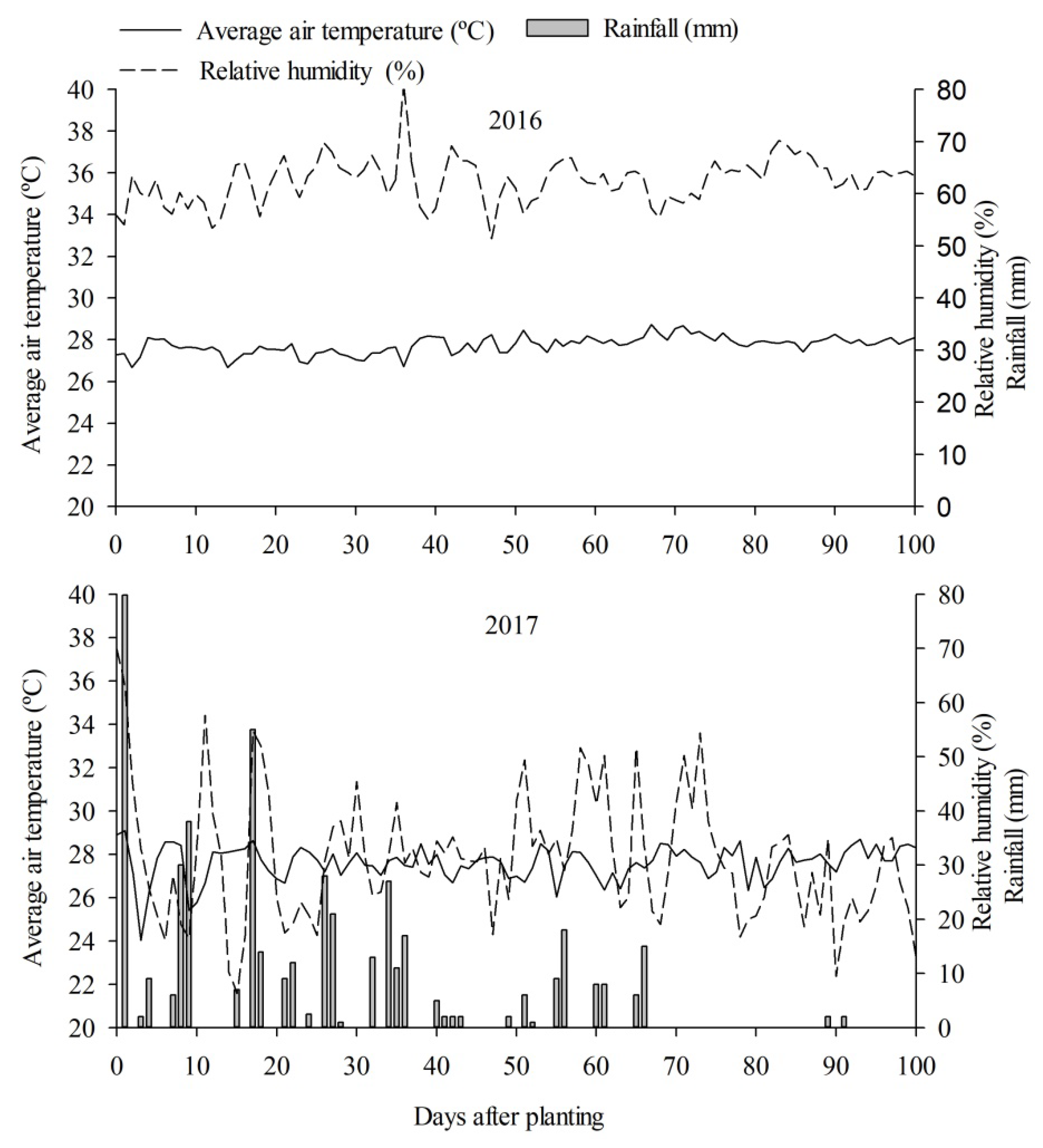
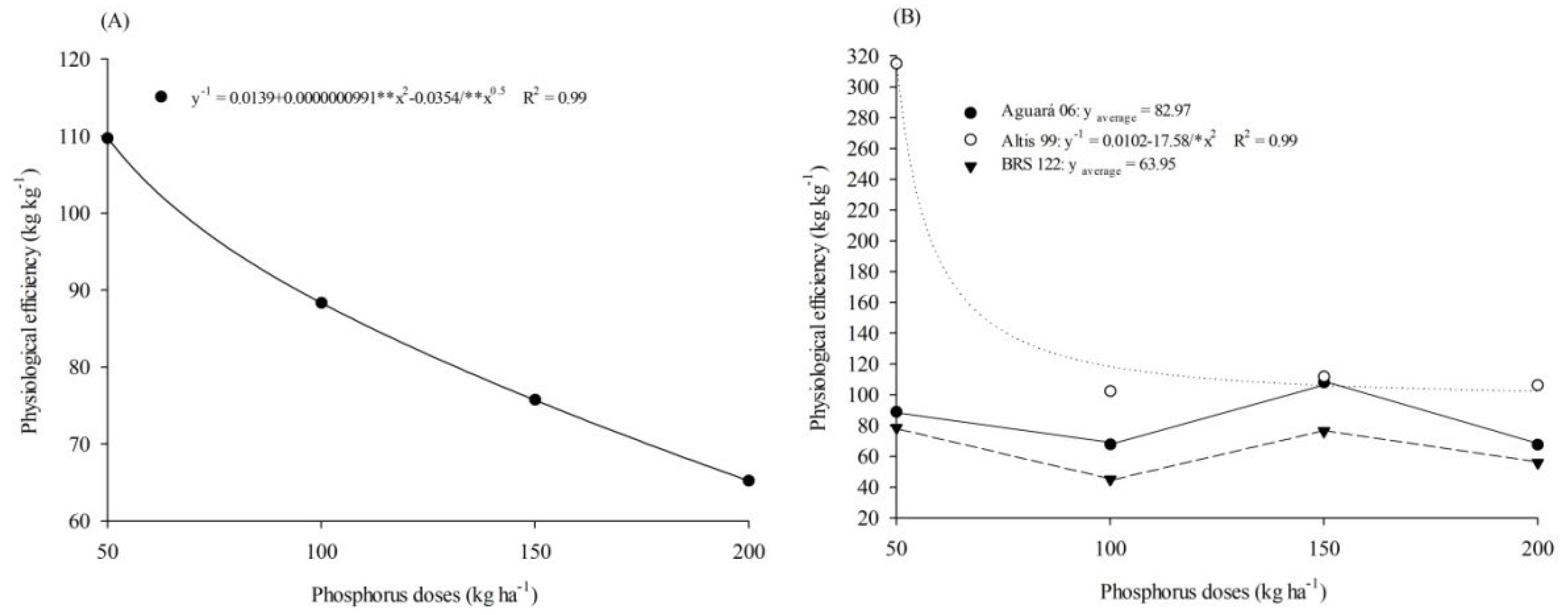
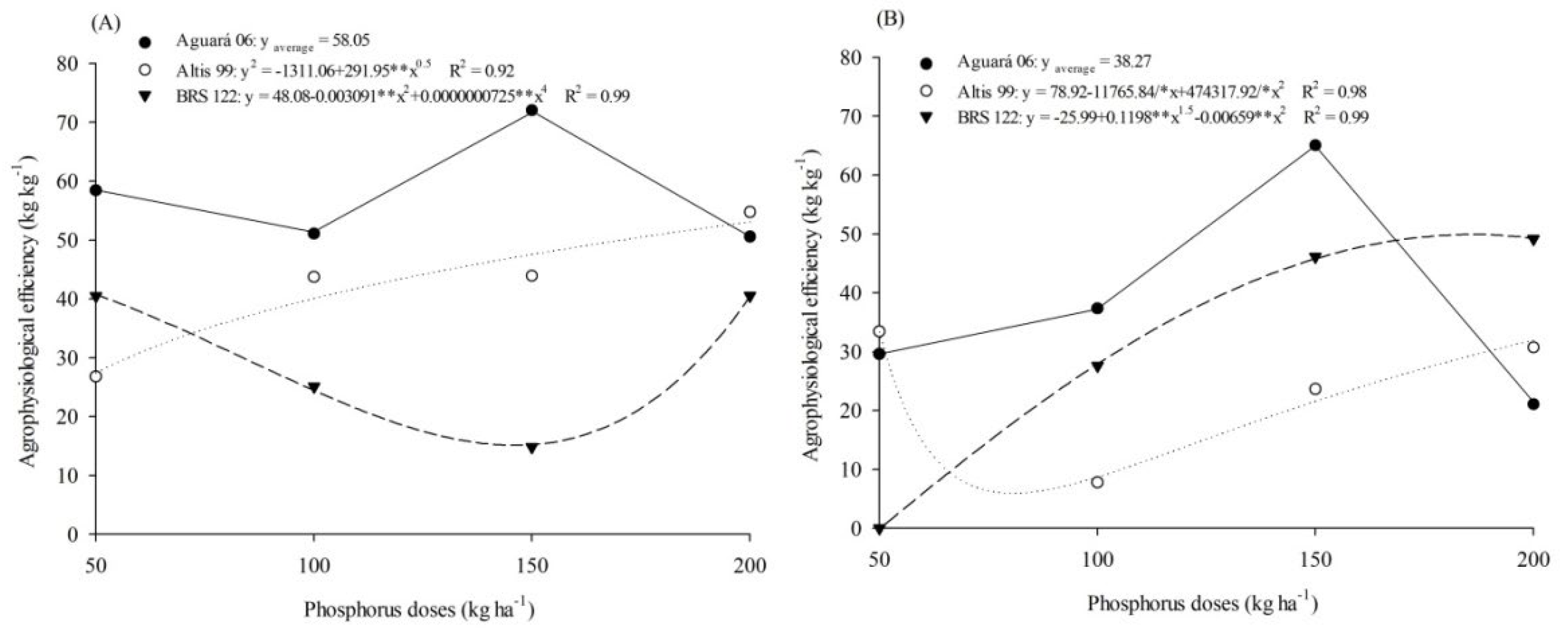

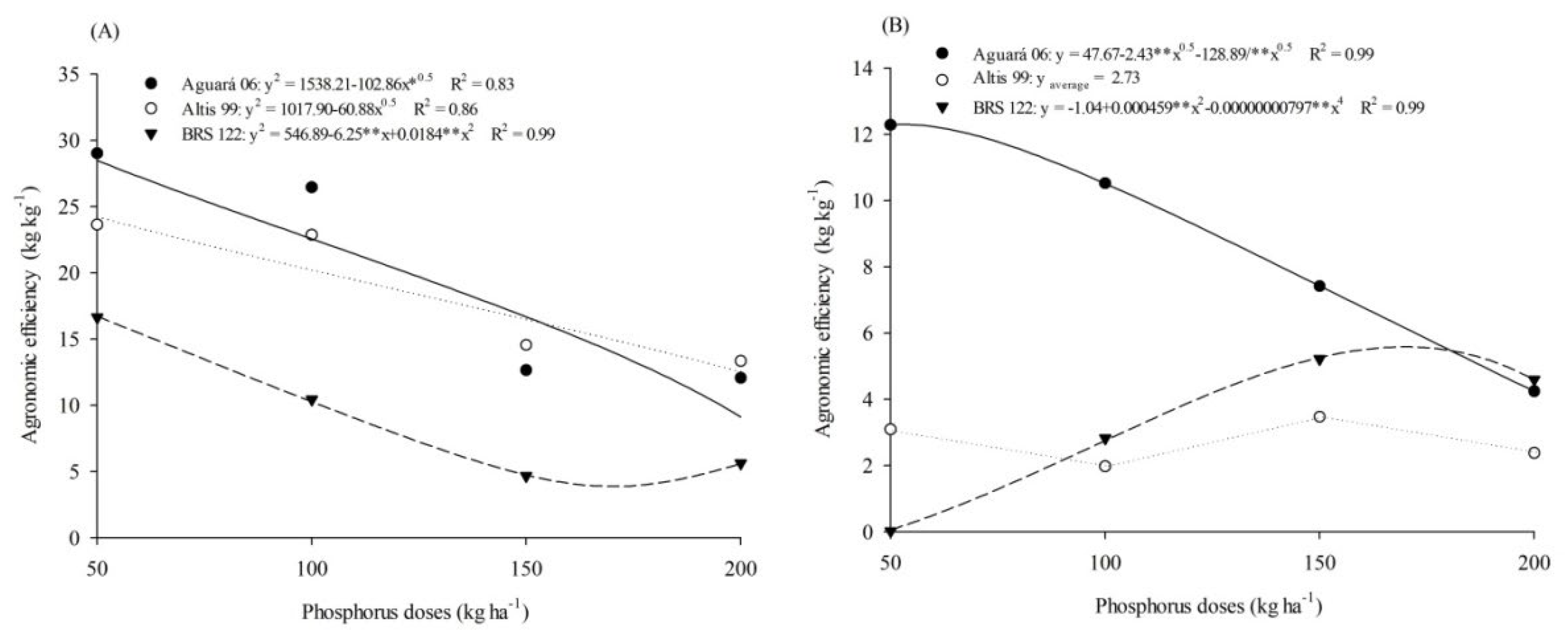
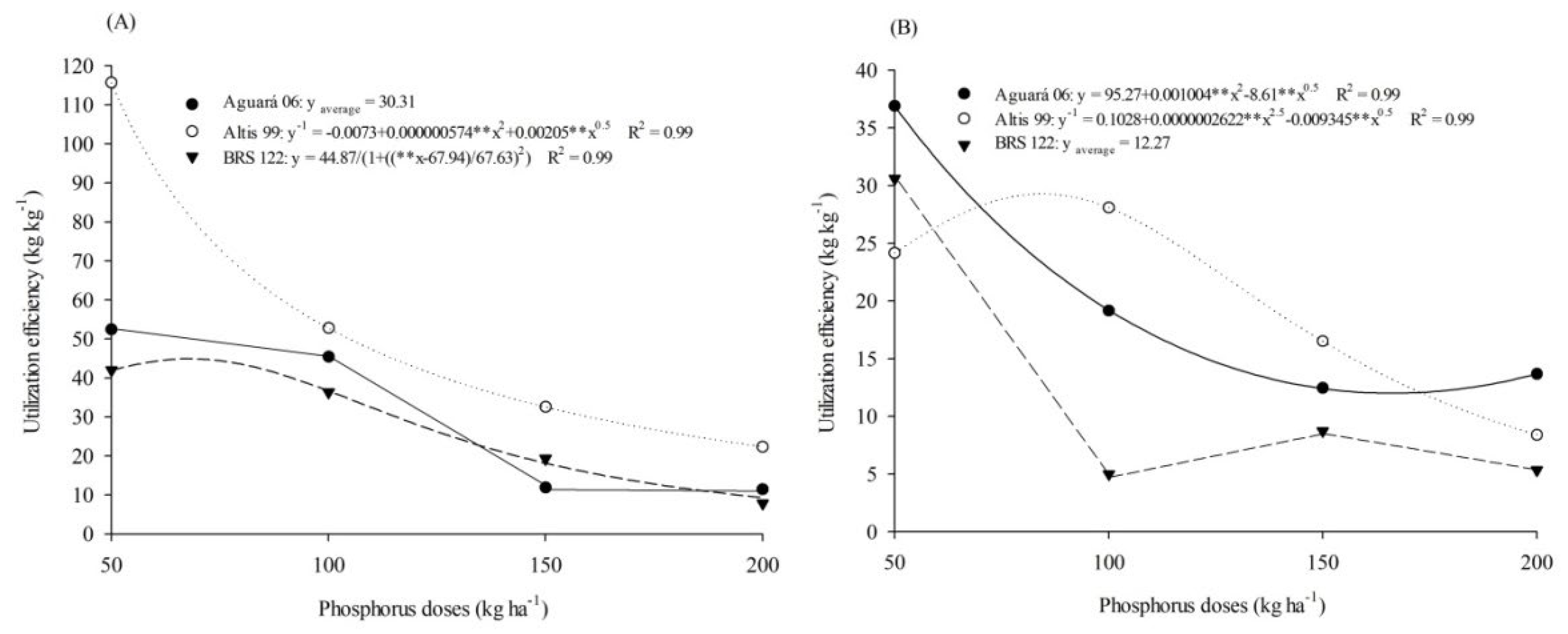
| Agronomic Efficiency in the 2016 Agricultural Harvest | ||||
| Grow Crops | Phosphorus Dose (kg ha−1) | |||
| 50 | 100 | 150 | 200 | |
| Aguará 06 | 29.03 a | 26.46 a | 12.66 a | 12.06 a |
| Altis 99 | 23.63 b | 22.87 b | 14.55 a | 13.34 a |
| BRS 122 | 16.65 c | 10.44 c | 4.67 b | 5.64 b |
| Agronomic Efficiency in the 2017 Agricultural Harvest | ||||
| Grow Crops | Phosphorus Dose (kg ha−1) | |||
| 50 | 100 | 150 | 200 | |
| Aguará 06 | 12.28 a | 10.52 a | 7.42 a | 4.24 a |
| Altis 99 | 3.09 b | 1.97 b | 3.47 c | 2.38 b |
| BRS 122 | 0.02 c | 2.83 b | 5.21 b | 4.59 a |
| Physiological Efficiency in the 2016 Agricultural Harvest | ||||
| Grow Crops | Phosphorus Dose (kg ha−1) | |||
| 50 | 100 | 150 | 200 | |
| Aguará 06 | 105.29 ab | 84.58 a | 68.38 b | 47.81 b |
| Altis 99 | 128.69 a | 99.85 a | 97.94 a | 91.22 a |
| BRS 122 | 95.27 b | 80.51 a | 60.87 b | 56.62 b |
| Physiological Efficiency in the 2017 Agricultural Harvest | ||||
| Grow Crops | Phosphorus Dose (kg ha−1) | |||
| 50 | 100 | 150 | 200 | |
| Aguará 06 | 88.81 b | 67.77 a | 107.81 a | 67.48 a |
| Altis 99 | 315.02 a | 102.27 a | 111.80 a | 106.12 a |
| BRS 122 | 78.51 b | 45.12 a | 76.32 a | 55.82 a |
| Dose of P2O5 | Grow Crops | 1st Agricultural Crop | 2nd Agricultural Crop |
|---|---|---|---|
| 50 kg ha−1 | Aguará 06 | 58.44 aA | 29.59 aB |
| Altis 99 | 26.82 bA | 33.40 aA | |
| BRS 122 | 40.47 bA | 0.00 bB | |
| 100 kg ha−1 | Aguará 06 | 51.08 aA | 37.35 aA |
| Altis 99 | 43.75 aA | 7.76 bB | |
| BRS 122 | 25.09 bA | 27.58 aA | |
| 150 kg ha−1 | Aguará 06 | 72.07 aA | 65.07 aA |
| Altis 99 | 43.93 bA | 23.63 cB | |
| BRS 122 | 14.80 cB | 46.12 bA | |
| 200 kg ha−1 | Aguará 06 | 50.59 aA | 21.05 bB |
| Altis 99 | 54.76 aA | 30.71 bB | |
| BRS 122 | 40.51 aA | 49.17 aA |
| Dose of P2O5 | Grow Crops | 1st Agricultural Crop | 2nd Agricultural Crop |
|---|---|---|---|
| 50 kg ha−1 | Altis 99 | 54.22 bA | 42.38 aB |
| BRS 122 | 91.21 aA | 9.83 bB | |
| Aguará 06 | 45.01 bA | 42.45 aA | |
| 100 kg ha−1 | Altis 99 | 54.00 aA | 28.39 aB |
| BRS 122 | 53.43 aA | 28.11 aB | |
| Aguará 06 | 44.72 aA | 10.97 bB | |
| 150 kg ha−1 | Altis 99 | 17.71 bA | 11.88 aA |
| BRS 122 | 33.57 aA | 14.76 aB | |
| Aguará 06 | 31.85 aA | 11.63 aB | |
| 200 kg ha−1 | Altis 99 | 24.12 aA | 20.57 aA |
| BRS 122 | 24.70 aA | 8.03 bB | |
| Aguará 06 | 14.15 aA | 9.74 abA |
| Utilization Efficiency in the 2016 Agricultural Harvest | ||||
| Grow Crops | Phosphorus Dose (kg ha−1) | |||
| 50 | 100 | 150 | 200 | |
| Aguará 06 | 53.46 b | 45.40 ab | 11.90 b | 11.47 ab |
| Altis 99 | 115.67 a | 52.75 a | 32.54 a | 22.37 a |
| BRS 122 | 41.99 b | 36.34 b | 19.31 b | 7.84 b |
| Utilization Efficiency in the 2017 Agricultural Harvest | ||||
| Grow Crops | Phosphorus Dose (kg ha−1) | |||
| 50 | 100 | 150 | 200 | |
| Aguará 06 | 36.90 a | 19.16 b | 12.46 b | 13.66 a |
| Altis 99 | 24.16 c | 28.09 a | 16.50 a | 8.39 b |
| BRS 122 | 30.59 b | 5.00 c | 8.73 b | 5.35 b |
Publisher’s Note: MDPI stays neutral with regard to jurisdictional claims in published maps and institutional affiliations. |
© 2022 by the authors. Licensee MDPI, Basel, Switzerland. This article is an open access article distributed under the terms and conditions of the Creative Commons Attribution (CC BY) license (https://creativecommons.org/licenses/by/4.0/).
Share and Cite
de Oliveira, A.K.S.; Soares, E.B.; dos Santos, M.G.; Lins, H.A.; de Freitas Souza, M.; dos Santos Coêlho, E.; Silveira, L.M.; Mendonça, V.; Barros Júnior, A.P.; de Araújo Rangel Lopes, W. Efficiency of Phosphorus Use in Sunflower. Agronomy 2022, 12, 1558. https://doi.org/10.3390/agronomy12071558
de Oliveira AKS, Soares EB, dos Santos MG, Lins HA, de Freitas Souza M, dos Santos Coêlho E, Silveira LM, Mendonça V, Barros Júnior AP, de Araújo Rangel Lopes W. Efficiency of Phosphorus Use in Sunflower. Agronomy. 2022; 12(7):1558. https://doi.org/10.3390/agronomy12071558
Chicago/Turabian Stylede Oliveira, Anna Kézia Soares, Enielson Bezerra Soares, Manoel Galdino dos Santos, Hamurábi Anizio Lins, Matheus de Freitas Souza, Ester dos Santos Coêlho, Lindomar Maria Silveira, Vander Mendonça, Aurélio Paes Barros Júnior, and Welder de Araújo Rangel Lopes. 2022. "Efficiency of Phosphorus Use in Sunflower" Agronomy 12, no. 7: 1558. https://doi.org/10.3390/agronomy12071558
APA Stylede Oliveira, A. K. S., Soares, E. B., dos Santos, M. G., Lins, H. A., de Freitas Souza, M., dos Santos Coêlho, E., Silveira, L. M., Mendonça, V., Barros Júnior, A. P., & de Araújo Rangel Lopes, W. (2022). Efficiency of Phosphorus Use in Sunflower. Agronomy, 12(7), 1558. https://doi.org/10.3390/agronomy12071558






